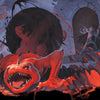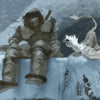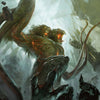How to Take Better Notes in Dungeons & Dragons

Written by Luke Hart
Today we’re talking about how players can improve their own game experience—and that of everyone else at the table—by taking good notes. Because in my experience, this is the number one player mistake.
Now, if you’re a game master with players like this—players who need this video more than they need a good shower or a stick of Old Spice, as difficult as that is to imagine—please share this with your players. And if you’re a player whose dungeon master shared this video with you—well, it’s either because you’re clueless, have the memory of gnat, and need to take some notes—or because the odor of a well fermented dumpster follows you around.
Watch or listen to this article by clicking the video below.
You’re probably thinking that all you need to do is write down some bullet points of what happened in the game session, and you’re good to go, right? Well, that’s certainly a good start. Shoot, most game masters would KILL for players who did only that. But if you made it through my ridiculous opening and got this far, I’ll give you a bit more than that. Because I’m nice like that, you know.
The real question is: WHAT EXACTLY should you take notes on? Every prepubescent teen running around the gymnasium during after-school D&D club knows how to write out the name of the NPC quest giver, what they want you to do, and how much lootz you’ll get when the job is done. And you certainly can’t write down everything that happened or is said during a game session.
The first key to good notes is ACTIVE LISTENING. Most people listen to others while planning their response. Most players listen to a villain monologuing while planning their backstab or whether they should cast fireball or wondering how many gold pieces their fancy helmet will go for. This is a mistake. Listen to UNDERSTAND, not to respond. And not just for villains monologuing. Whenever your dungeon master is dispensing information be it by NPC or narration—and when your fellow players are talking—your primary purpose should be to comprehend what is being communicated. Doing this avoids the trap of ASSUMING what the person is trying to say, and allows you to actually receive the intended message.
Because good notes can only be created based on GOOD INFORMATION. You’ve heard the saying “garbage in, garbage out” right? Of course you have; I just said it.
The second key to good notes is looking for non-verbal clues to identify what is important. Remember, you don’t want to write down every piece of drivel that an NPC spouts. Half the time they are just prattling on and one to fill out the game session—do you know how hard it is to fill four hours with action-packed excitement? Even Hollywood only aims for two hours, and—judging by the recent string of box office flops—even they usually fail at that. Or is that just Disney?
Anyway, point is, the game master will often give clues when something is important. Their posture changes, their mannerisms, they may stand up—or they may give the look of death at the one player who is ALWAYS having a side conversation so that he shuts up for a few seconds so everyone can hear what the DM has to say. When your game master gives any of these clues, it’s probably noteworthy. Like literally, take some notes already.
The third key—no, I don’t know how many they are. Yes, I know you’re writing a comment right now with everything bullet pointed so that people don’t have to watch this video and can just upvote your wonderful view-time stealing comment. But I’m not going to tell you how many there are, because I’ll make sure that YOU at least need to watch the entire video to get them all.
The third key to good notes is ASKING QUESTIONS. Dungeon masters aren’t perfect. Despite our ruggedly handsome faces and impeccable hygiene habits, we don’t always communicate clearly, and sometimes we forget to tell you important details. Even if we are literally reading directly from the adventure module in a lame monotonous voice that has you practically falling asleep. So, if something doesn’t make sense, ask.
Also ask probing questions. Seek to learn more. Game masters’ brains are overflowing with information that we are just itching to tell you. We could spend hours telling you about our wonderful worlds and adventures that we spend hours and hours creating—unless we didn’t, and we’re just pulling it all out of our butts. But even then, please ask. I assure you, our butts are filled with endless crap that we are happy to present to the world to marvel at.
Okay, now you got the important information, you crack open the notebook, and you’re ready to take some notes. But stop right there. This isn’t 11th grade and Mrs. Brown isn’t going be grading whatever your write in that filthy notebook—no, it doesn’t need a shower, but Old Spice just might help. What, you think notes can’t stink? I assure you, they can.
So, what you write in this thing should be customized for you; what you need; preferably legible—to yourself at least. Use short, concise sentences that focus on the important crap. Abbreviations are your friend. Consider outlines, numbering, and bullet lists.
If you want to feel superior to the unwashed masses—and judging by this video there apparently are lots of them—you can even use fancy pants notetaking methods such as the Cornell Method. Doing so first and foremost allows you to use scientific-sounding terms like Notes and Cues and Summary—once you throw around terms like that, who can doubt your prowess?—and probably even take some mean notes. I won’t delve into the Cornell Method here, but if you ask nicely in the comments, I’ll be happy to Google it for you.
Consider coding your notes. Different color pens or highlighters—red for locations, blue for plot hooks, green for NPC names. Use symbols or marks in the notebook to help you find important stuff faster. Stars and butterflies and girly hearts. Make a coodee-catcher while you’re at it. Who says that notes have to go in a notebook?
Blocks of text got you down? Use the Mapping Method and take visual notes. Diagram your notes in small boxes, and connect related items with lines. These are often called Mind Maps. I’ll even have my wonderful editor throw some fancy broll here to show you what I mean. Right Zac? Zac? Draw pictures, make categories—nothing is off limits.
Except being a moron. That’s off limits, and do you know what the most moronic, braindead thing you can possibly do is? Go to all this effort of taking notes, and then NOT REVIEWING THEM. Now, you’d think after all this effort of elevating yourself above the unwashed masses—literally, I hope—you wouldn’t return to your own vomit. Usually I’d tell you a story about my cat Squirty Pie right here, but I’ll let you just use your imagination.
What is the point of notes if you don’t review them prior to your game session? Why take notes if, when your dungeon master asks for volunteers to recap the last game session, you’re hiding behind your dice tower and Monster cans, eyes downcast, just like everyone else?
But don’t just review your notes, transcribe them elsewhere for future reference and to reinforce them in your mind; critically evaluate your notes form time; see where you can improve; compare your notes with the notes of other players. Rise above the unwashed masses together!
Yeah, you’re right, I’ve gone too far. I should have just told you to buy a notebook and write something—anything—down in it. But what can I say? I’m a hopeless optimistic.
The Ultimate 5e Anthology for DMs
Lairs & Legends 2 and Loot & Lore 2 are the ultimate game master resource! These two massive books put an anthology of everything you need to run amazing games for YEARS at your fingertips.
- Over 30 Adventures
- 30 Stand-Alone Encounters
- More than 100 Monsters
- Traps and Puzzles
- 6 New Rule Sets
- And much more!
These books are written to make running the game easy for new and veteran GMs. Each resource is built with intuitive formatting, clear wording, and evocative art. You’ll never again have to dig through dense paragraphs to find critical details you need during a live session.
These 5e resources are designed to scale to your needs, whether it’s a quick drag-and-drop trap to add some spice to your session or complete adventures that span levels 1 to 20. The sky’s the limit with what your games can become with Lairs & Legends 2 and Loot & Lore 2.
-
Posted in
Game Master How-To Articles






